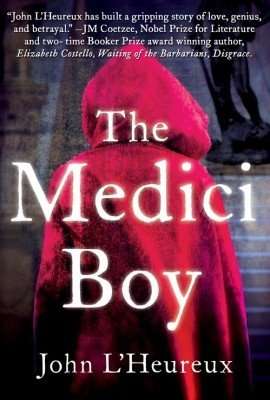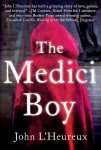Book Review – THE MEDICI BOY by John L’Heureux

The Medici Boy Synopsis:
The worlds of art, politics and passion collide in John L’Heureux’s masterful new novel, The Medici Boy. With rich composition, L’Heureux ingeniously transports the reader to Donatello’s Renaissance Italy—directly into his bottega, (workshop), as witnessed through the eyes of Luca Mattei, a devoted assistant.
While creating his famous bronze of David and Goliath, Donatello’s passion for his enormously beautiful model and part time rent boy, Agnolo, ignites a dangerous jealousy that ultimately leads to murder. Luca, the complex and conflicted assistant, will sacrifice all to save Donatello, even his master’s friend–the great patron of art, Cosimo de’ Medici.
John L’Heureux’s long-awaited novel delivers both a monumental and intimate narrative of the creative genius, Donatello, at the height of his powers. With incisive detail, L’Heureux beautifully renders the master sculptor’s forbidden homosexual passions, and the artistry that enthralled the powerful and highly competitive Medici and Albizzi families. The finished work is a sumptuous historical novel that entertains while it delves deeply into both the sacred and the profane within one of the Italian Renaissance’s most consequential cities, fifteenth century Florence. (Astor+Blue Editions)
BOOK REVIEW by Tony Ziemek
Renaissance Italy. Today, we might experience it among crowds of fellow tourists, shuffling through the Sistine Chapel or the Uffizi. We may be tired, thirsty, guiltily bored but we can tick the box of tourist experiences or that bucket list of great art.
How refreshing then, to be right there at the creation of extraordinary art. In 15th Century Florence they were still making this stuff up as they went along. Artists and artisans rediscovered the confidence to explore possibilities. For centuries, the achievements of the classical world had seemed unattainable but now they studied and relearned the techniques of the past to project into an optimistic future.
Well, apart from the Black Death, of course. Hard to imagine that this was a plague that wiped out around half of Europe’s people and could pop up in your village or town at any time. Its source was unknown, all treatments were useless and you watched your family and friends die, horribly. The result seems to have been a more intense focus on the vitality of daily experience. People already lived short lives and they fearfully but briskly, spun the wheel of fortune each and every day.
Which leads us to sodomy and more broadly, pederasty. Intimate relations between older men and teenage boys were apparently tolerated in Florence (another influence from the classical world?) and would appear to have been a powerful influence on artists and the arts. These are central to the plot of the novel but officialdom had some reservations:
And so it came about that in 1432, in a mood of desperation, the Ufficiali di Notte was established to crush out sodomy now and forever. Or, failing that, to make the practice of it so dangerous that the streets would be safe from sodomites, more or less, and citizens could sleep soundly knowing that their sons and daughters were as pure and virginal as they themselves had been in their youth. One last attempt to legislate virtue.
Can’t you just hear that irony drip! Perhaps I should point out though, that The Medici Boy is a not a gay romp through Renaissance art history. It is a story that enthralls and entertains as we follow the life of Luca Mattei, assistant to the great Donatello. Even if you have only the mildest interest in art history, it is unreservedly, a pleasure to read, with characters that are not just cardboard cut outs, with supporting roles to the headline acts.
The Medici Boy is also well researched as is evident in some of the fascinatingly details. For example, here is a paragraph on the training of an apprentice artisan:
We learned to cut the quill, to tint the paper for drawing, to trace and to copy from nature. To apply size to board or cloth, to gesso and gild and burnish, to temper and lay in, to pounce, stamp, and punch, to mark out, paint, embellish and surface a panel. These were never-ending tasks. The work of an artisan is in large part preparation. He taught us to work on a wall, to plaster, to paint in fresco. Varnishing, illuminating, the preparation of mosaic gold.
Depicting the necessary combination of this artisanal skill with art and passion is one of the triumphs of The Medici Boy. I feel that I could now make a clumsy attempt at a bronze sculpture using the ancient ‘lost wax’ technique. Sadly, I know that it would not look like Donatello’s David, as I lack the sense of meticulous spacial design and a passion for young male bodies that together, may lead to sublime creations. The author notes:
ON MY FIRST visit to Florence I had the exhilarating experience of seeing Michelangelo’s David at the Accademia and later that same day seeing Donatello’s David in the Bargello. Michelangelo’s deeply moved me but Donatello’s was a revelation. It was naked in every sense and seemed to me personal, erotic, a testament to the sculptor’s sexual obsession for the teenaged boy he had created. Someone, I thought, should write a novel about it.
I’m glad that he did.
BOOK RATING: The Story 4.5 / 5 ; The Writing 4.5 / 5

BUY THIS BOOK:
Book Depository | Booktopia(Aus) | B&N | Amazon
Genre: Historical, Romance, Literature
~ Tony Ziemek is the lead editor of Ed Fresh Editorial Services.
About the Author, John L’Heureux
Award-winning poet, novelist, and short story writer, John L’Heureux has taught at Georgetown University, Tufts, Harvard, and for over 35 years in the English Department of Stanford University where he was Lane Professor of Humanities. There he received the Dean’s Award for Excellence in Teaching and again in 1998.
 A prolific writer, L’Heureux has written more than twenty books of fiction, short fiction and poetry. His works have appeared in the Atlantic Monthly, Esquire, Harper’s, The New Yorker, and have been included in dozens of anthologies including Best American Stories and Prize Stories: the O. Henry Awards.
A prolific writer, L’Heureux has written more than twenty books of fiction, short fiction and poetry. His works have appeared in the Atlantic Monthly, Esquire, Harper’s, The New Yorker, and have been included in dozens of anthologies including Best American Stories and Prize Stories: the O. Henry Awards.
John L’Heureux has twice received writing fellowships from the National Endowment for the Arts and in 2006 he was awarded a Guggenheim Grant to do research for The Medici Boy, his new novel. He is retired and lives in Palo Alto with his wife Joan. See John’s website http://johnlheureux.com/.
Other reviews of The Medici Boy
Goodreads, Washington Post, Open Letters Monthly, Historical Fiction Obsession, DawnReadLove
* Receiving this ebook from Astor+Blue did not impact the expression of honest opinions in the review above.
